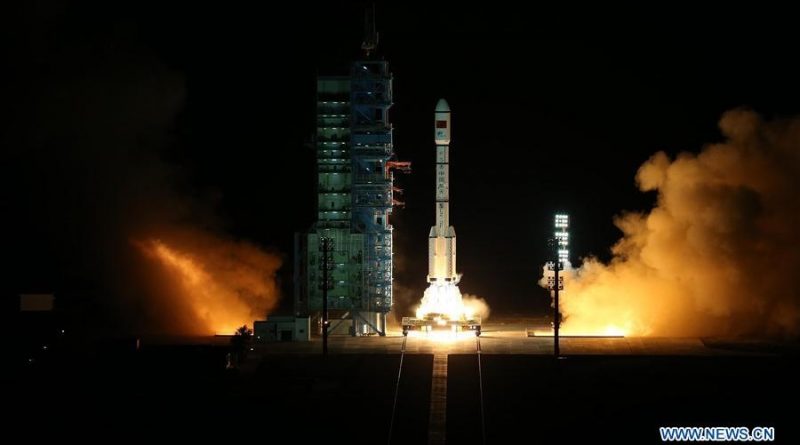China’s ‘Heavenly Palace’ Space Laboratory arrives in Orbit after flawless Launch
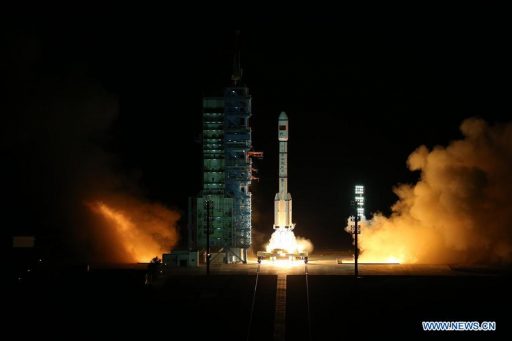
China successfully placed its mini Space Station Tiangong-2 into orbit on Thursday after a flawless nighttime launch by its Long March 2F carrier rocket.
The ‘Heavenly Palace’ lifted off at 14:04 UTC from the Jiuquan Satellite Launch Center and enjoyed a ten-minute ride into orbit to mark the start of a two-year mission.
Tiangong-2 builds on the first Tiangong mission launched in 2011 and is considered China’s first functional space laboratory, tasked with a mission to demonstrate key technologies needed in the operation of a large, modular Space Station that will begin assembly toward the end of the decade.
The Mir-style Space Station China is building is envisioned to be fully operational by 2022 for a continuous Chinese presence in Low Earth Orbit. Assembly is expected to begin in 2018 with the launch of the Tianhe core module to which subsequent laboratory modules will be added to enable cutting-edge research to be carried out in orbit.
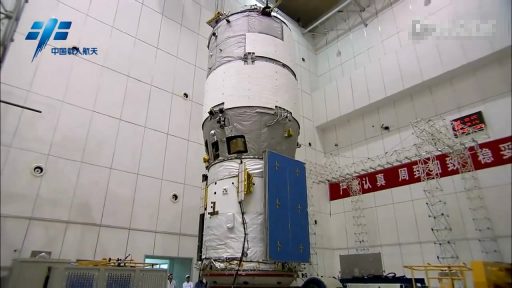
Tiangong-1 – China’s first space station module – demonstrated automated and manual docking maneuvers in space as well as the operation of a pressurized spacecraft and its life support systems over an extended mission duration.
After being visited by the uncrewed Shenzhou-8 spacecraft, Tiangong-1 supported two crewed missions, the first, Shenzhou-9 with a 13-day duration, and the second, Shenzhou-10, lasting 15 days and setting a new record for the longest Chinese flight.
Although Tiangong-1 hosted some experiments performed by its visiting crews, it was largely dedicated to a shakedown mission to learn about human habitation in orbit – providing the lessons needed to make life in space more convenient and permit crews to complete a busy scientific program.
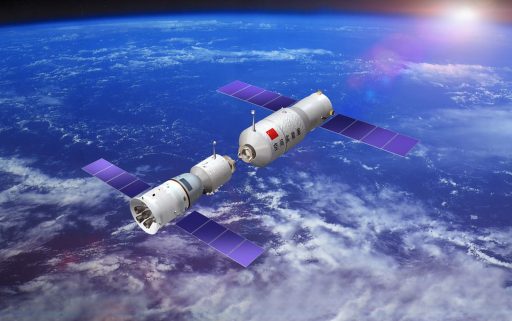
Tiangong-2, originally built to be the backup of the first Heavenly Palace, underwent modifications based on the recommendations of the Tiangong-1 crews to provide better living and working quarters. Early in its two-year primary mission, Tiangong-2 will be visited by a pair of crew members for a month-long stay to perform a range of experiments aboard the laboratory module and, in the process, push China’s record for the longest space mission.
After the Shenzhou-11 spacecraft departs, Tiangong-2 will remain in orbit to wait for Tianzhou-1, the first Chinese cargo spacecraft embarking on a demonstration mission next year to ensure China’s future station can receive supplies from the ground. A prime goal of the flight will be the demonstration of fuel and water transfer to Tiangong – an essential part of future resupply flights
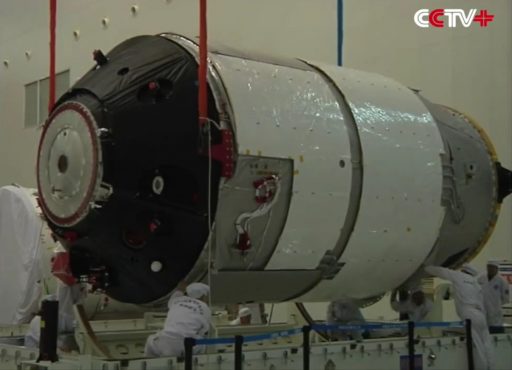
Built on the specifications of Tiangong-1, the TG-2 spacecraft appears identical when looking at its exterior. It is comprised of a 2.8-meter diameter Service Module hosting a pair of solar arrays and the propulsion system, and a 3.35-meter Orbital and Experiment Module with the craft’s docking system. Overall, Tiangong-2 is 10.4 meters long and has a launch mass of 8,600 Kilograms – the upper end of the Long March carrier rocket’s performance.
Hosted by Tiangong-2 is a combination of internal payloads to be operated by the crew and external instruments that can be controlled from the ground to utilize the space lab as an orbital platform for Earth and Space research while no crew is on board.
Also installed on the laboratory is China’s largest robotic arm to be deployed to space. Measuring over ten meters in length, the seven-jointed arm will complete a demonstration in space to ensure its design can support the critical task of relocating modules on China’s upcoming orbital complex.
>>Tiangong-2 Technical Overview
The external payloads on the Tiangong-2 space lab include a microwave altimeter for Earth surface and ocean monitoring, a wide-field imager for ocean and land surveys as well as a multispectral spectrometer for atmospheric science. Also pointed at Earth is a Quantum Communications System, further cementing China’s commitment to the exploration of this novel communications technology after launching the world’s first satellite hosting a quantum communications payload earlier this year.
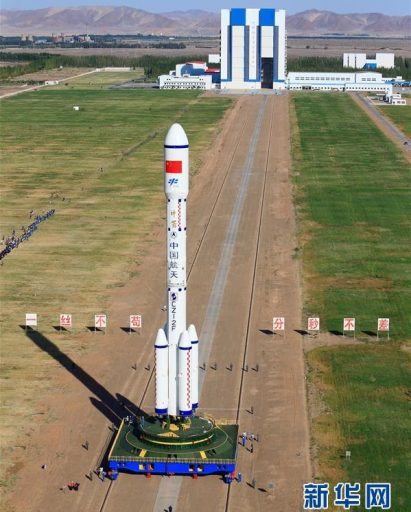
Tiangong-2 also hosts POLAR, a collaboration between China, Switzerland and Poland, to study the dynamics of Gamma-Ray Bursts. A fountain atomic clock tested in space for the first time on TG-2 is expected to be more precise than conventional space-based clocks which could be used for the improvement of space-based navigation systems.
Heading into a lengthy countdown at the Jiuquan Satellite Launch Center in the Gobi desert, the Long March 2F rocket underwent the final checks and reconfigurations as the sun set over the launch site. As an all-hypergolic rocket, Long March 2F was fueled for liftoff the day before launch, being loaded with over 400 metric tons of Unsymmetrical Dimethylhydrazine and Nitrogen Tetroxide.
According to media reports, the countdown proceeded nominally and the 52-meter tall rocket was revealed on its launch pad with one hour to go when the Service Structure halves opened up. The final steps of the countdown saw Tiangong-2 switching to battery power before Long March 2F entered a choreographed sequence to transition to internal power itself, followed by the handover of control to the vehicle and the pressurization of tanks for liftoff.
Ignition of the rocket’s four strap-on boosters and large core stage was commanded four seconds ahead of liftoff, accompanied by the typical puff of toxic fumes rising from the launch pad.
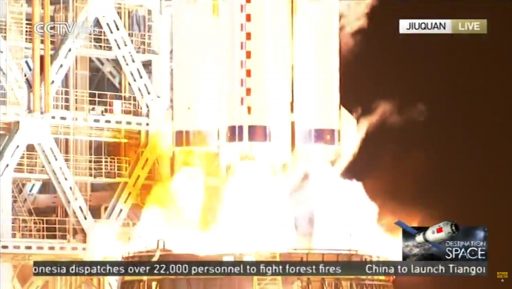
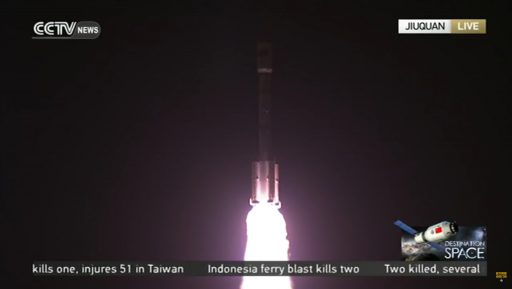
Liftoff occurred at precisely 14:04:12 UTC; 22:04 local time as Long March 2F rumbled off with a total thrust of 604 metric ton-force, lighting up the night skies over Jiuquan where many observers had gathered to witness China’s next human spaceflight milestone.
The 480-metric ton rocket balanced vertically for 12 seconds before pitching over and rolling onto a south-easterly flight path taking the vehicle across China’s mainland before heading out over the Pacific Ocean where tracking ships had been deployed to deliver a continuous relay of data from the ascending launcher.
Burning 1,750 Kilograms of hypergolics per second, Long March 2F quickly accelerated to the speed of sound and passed the point of Maximum Dynamic Pressure on its way into orbit. Commentary from the Chinese Mission Control Center in Beijing continued reporting good radar tracking and stabilization on the vehicle throughout the early stages of the flight.
The four boosters, each 15.3 meters long and 2.25m in diameter, shut down their 740kN YF-20B engines two and a half minutes into the flight after burning over 40 metric tons of propellants. Separation of the boosters occurred as planned at T+2:35 with the help of pyrotechnics and separation rockets.

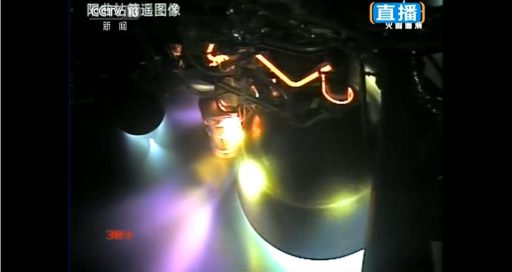
Immediately after booster separation, the 28-meter long core stage used its YF-21B engine cluster to stabilize the vehicle and then shut down the four YF-20B engines, exhausting a 186,500-Kilogram propellant supply.
Handing off to the second stage at T+2 minutes and 40 seconds, the core made a clean separation, enabling the upper stage to ignite its YF-22B main engine and YF-23 steering engine to lift Tiangong-2 into orbit with a total thrust of 80 metric ton force. Onboard cameras showed the engines glowing brightly as they continued to push Tiangong-2 into orbit, aiming for a cutoff target 200 Kilometers in altitude.
The second stage shut down its main engine after a burn of exactly five minutes while the four-chamber vernier continued to fire for another 100 seconds to finish the orbital insertion with high precision.
Cutoff on the upper stage was quickly followed by the separation of the Tiangong-2 space lab nine minutes and 40 seconds after launch into what was reported to be a 200 by 347-Kilometer transfer orbit, inclined 42.8 degrees.
Live onboard video showed the spacecraft floating away from the second stage, immediately firing its maneuvering thrusters to pull away from the booster and then stabilize its orientation ahead of the deployment of its two power-generating solar arrays.
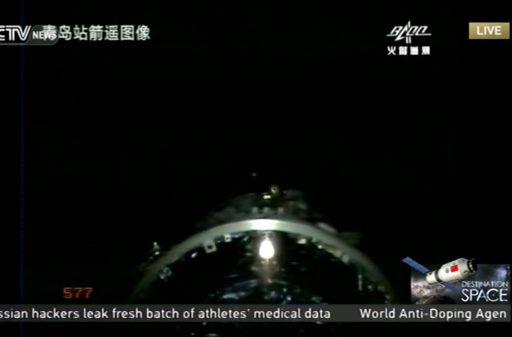
Chinese mission controllers were quick to confirm Tiangong-2 was in good condition when heading out on its first orbit around Earth, the first of many laps around the planet expected over the course of a mission of at least two years.
With Tiangong-2 safely in orbit, the way is clear for the Shenzhou 11 mission expected to lift off in mid-October with a two-man crew to live and work aboard Tiangong-2 for 30 days. Shenzhou-11 will also use a Long March 2F rocket that is expected to begin stacking at Jiuquan in the coming days, though final clearance for the mission will not be given until Tiangong-2 has been put through an extensive testing campaign in orbit.

